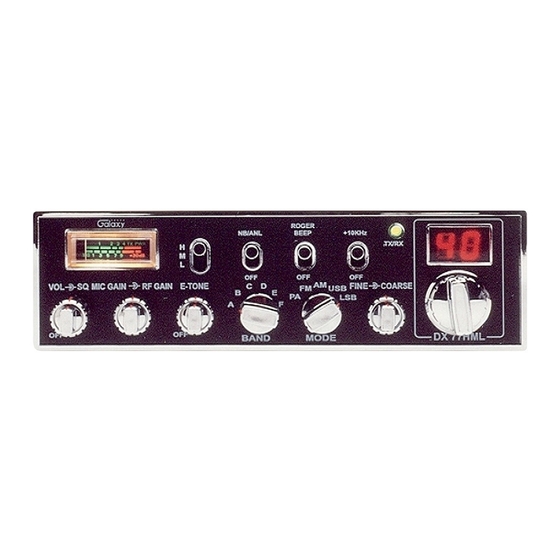Galaxy DX-77HML Instrukcja obsługi - Strona 4
Przeglądaj online lub pobierz pdf Instrukcja obsługi dla Transceiver Galaxy DX-77HML. Galaxy DX-77HML 10 stron. Full channels with +10khz am/fm/usb/lsb/pa mobile transceiver with roger beep

IGNITION NOISE INTERFERENCE
Use of a mobile receiver at low signal levels is normally limited by the
presence of electrical noise. The primary source of noise in automobile
installations is from the generator and ignition system in the vehicle. Under
most operating conditions, when signal level is adequate, the background
noise does not present a serious problem. Also, when extremely low level
signals are being received, the transceiver may be operated with vehicle
engine turned off. The unit requires very little current and therefore will not
significantly discharge the vehicle battery.
In some installation ignition interference may be high enough to make
good communications impossible. The electrical noise may come from
several sources. Many possibilities exist and variations between vehicles
require different solutions to reduce the noise.
ANTENNA
A vertically polarized, quarter-wavelength whip antenna provides the
most reliable operation and greatest range. Shorter, loaded-type whip
antennas are more attractive, compact and adequate for applications where
the maximum possible distance is not required. Also, the loaded whips do not
present the problems of height imposed by a full quarter-wavelength whip.
Mobile whip antennas utilize the metal body of the vehicle as a ground
plane. When mounted at a corner of the vehicle they are slightly directional,
in the direction of the body of the vehicle. For all practical purpose, however,
the radiation pattern is nondirectional. The slight directional characteristic
will be observed only at extreme distance. A standard antenna connector
(type SO239) is provided on the transceiver for easy connection to a standard
PL 259 cable termination.
If the transceiver is not mounted on a metal surface, it is necessary to
run a separate ground wire from the unit to a good metal electrical ground in
the vehicle. When installed in a boat, the transceiver will not operate at
maximum efficiency without a ground plate, unless the vessel has a steel
hull.
Before installing the transceiver in a boat, consult your dealer for
information regarding an adequate grounding system and prevention of
electrolysis between fittings in the hull and water.
EXTERNAL SPEAKER
The external speaker jack (EXT.SPK) on the rear panel is used for
remote receiver monitoring. The external speaker should have 8 ohms
impedance and be able to handle at least 4 watts. When the external speaker
is plugged in, the internal speaker is disconnected.
- 5 -
Operation
CONTROL FUNCTIONS
There are fourteen controls and three indicators on the front panel of your
transceiver.
FRONT PANEL
1. OFF/ON/VOLUME (inner dual concentric): Turn clockwise to apply
power to the unit and to set the desired listening level. During normal
operation, the VOLUME control is used to adjust the output level
obtained either at the transceiver speaker or the external speaker, if used.
2. SQUELCH CONTROL (outer dual concentric): This control is used
to cut off or eliminate receiver background noise in the absence of an
incoming signal. For maximum receiver sensitivity it is desired that the
control be adjusted only to the point where the receiver background
noise or ambient backgrounds noise is eliminated. Turn fully
counterclockwise then slowly clockwise until the receiver noise
disappears. Any signal to be received must now be slightly stronger than
the average received noise. Further clockwise rotation will increase the
threshold level, which a signal must overcome in order to be heard. Only
strong signals will be heard at a maximum clockwise setting.
3. MIC GAIN CONTROL (inner dual concentric): Adjusts the
microphone gain in the transmit and PA modes. This controls the gain to
the extent that full talk power is available several inches away from the
microphone.
- 6 -
